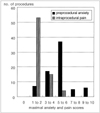1. Mueller PR, Biswal S, Halpern EF, Kaufman JA, Lee MJ. Interventional radiologic procedures: patient anxiety, perception of pain, understanding of procedure, and satisfaction with medication-a prospective study. Radiology. 2000. 215:684–688.
2. Harshfield DL, Teplick SK, Brandon JC. Pain control during interventional biliary procedures: epidural anesthesia vs iv sedation. AJR Am J Roentgenol. 1993. 161:1057–1059.
3. Lang EV, Chen F, Fick LJ, Berbaum KS. Determinants of intravenous conscious sedation for arteriography. J Vasc Interv Radiol. 1998. 9:407–412.
4. Kennedy PT, Kelly IM, Loan WC, Boyd CS. Conscious sedation and analgesia for routine aortofemoral arteriography: a prospective evaluation. Radiology. 2000. 216:660–664.
5. Wagner HJ, Nowacki J, Klose KJ. Propofol versus midazolam for sedation during percutaneous transluminal angioplasty. J Vasc Interv Radiol. 1996. 7:673–680.
6. Martin ML, Lennox PH. Sedation and analgesia in the interventional radiology department. J Vasc Interv Radiol. 2003. 14:1119–1128.
7. Skehan SJ, Malone DE, Buckley N, Matsumoto S, Rawlinson J, Ting G, et al. Sedation and analgesia in adult patients: evaluation of a staged-dose system based on body weight for use in abdominal interventional radiology. Radiology. 2000. 216:653–659.
8. Whitwam JG. Minimally invasive therapy--implications for anaesthesia. Anaesthesia. 1993. 48:937–939.
9. Bluemke DA, Breiter SN. Sedation procedures in MR imaging: safety, effectiveness, and nursing effect on examinations. Radiology. 2000. 216:645–652.
10. American Society of Anesthesiologists Task Force on Sedation and Analgesia by Non-Anesthesiologists. Practice guidelines for sedation and analgesia by non-anesthesiologists. Anesthesiology. 2002. 96:1004–1017.
11. Innes G, Murphy M, Nijssen-Jordan C, Ducharme J, Drummond A. Procedural sedation and analgesia in the emergency department. Canadian Consensus Guidelines. J Emerg Med. 1999. 17:145–156.
12. Krauss B, Green SM. Sedation and analgesia for procedures in children. N Engl J Med. 2000. 342:938–945.
13. Arepally A, Oechsle D, Kirkwood S, Savader SJ. Safety of conscious sedation in interventional radiology. Cardiovasc Intervent Radiol. 2001. 24:185–190.
14. Monk TG. Clinical applications of monitored anesthesia care. Minim Invasive Therapy. 1994. 3:17S–20S.
15. McDermott VG, Chapman ME, Gillespie I. Sedation and patient monitoring in vascular and interventional radiology. Br J Radiol. 1993. 66:667–671.
16. Yaster M, Nichols DG, Deshpande JK, Wetzel RC. Midazolam-fentanyl intravenous sedation in children: case report of respiratory arrest. Pediatrics. 1990. 86:463–467.
17. Michalodimitrakis M, Christodoulou P, Tsatsakis AM, Askoxilakis I, Stiakakis I, Mouzas I. Death related to midazolam overdose during endoscopic retrograde cholangiopancreatography. Am J Forensic Med Pathol. 1999. 20:93–97.
18. Bailey PL, Pace NL, Ashburn MA, Moll JW, East KA, Stanley TH. Frequent hypoxemia and apnea after sedation with midazolam and fentanyl. Anesthesiology. 1990. 73:826–830.
19. Cragg AH, Smith TP, Berbaum KS, Nakagawa N. Radomized double-blind trial of midazolam/placebo and midazolam/fentanyl for sedation and analgesia in lower-extremity angiography. AJR Am J Roentgenol. 1991. 157:173–176.
20. Ben-Shlomo I, abd-el-Khalim H, Ezry J, Zohar S, Tverskoy M. Midazolam acts synergistically with fentanyl for induction of anaesthesia. Br J Anaesth. 1990. 64:45–47.
21. Lind LJ, Mushlin PS. Sedation, analgesia, and anesthesia for radiologic procedures. Cardiovasc Intervent Radiol. 1987. 10:247–253.
22. Ayre-Smith G. Fentanyl and midazolam: an alternative to diazepam. Radiology. 1987. 164:285.
23. Sacchetti A, Schafermeyer R, Geradi M, Graneto J, Fuerst RS, Cantor R, et al. Pediatric analgesia and sedation. Ann Emerg Med. 1994. 23:237–250.
24. Murphy MF. Sedation. Ann Emerg Med. 1996. 27:461–463.
25. Green SM, Krauss B. Procedural sedation terminology: moving beyond "conscious sedation". Ann Emerg Med. 2002. 39:433–435.
26. Cote CJ. "Conscious sedation": time for this oxymoron to go away! J Pediatr. 2001. 139:15–17.
27. Miller DL, Wall RT. Fentanyl and diazepam for analgesia and sedation during radiologic special procedures. Radiology. 1987. 162:195–198.
28. Lundgren S, Rosenquist JB. Amnesia, pain experience, and patient satisfaction after sedation with intravenous diazepam. J Oral Maxillofac Surg. 1983. 41:99–102.







 PDF
PDF ePub
ePub Citation
Citation Print
Print


 XML Download
XML Download